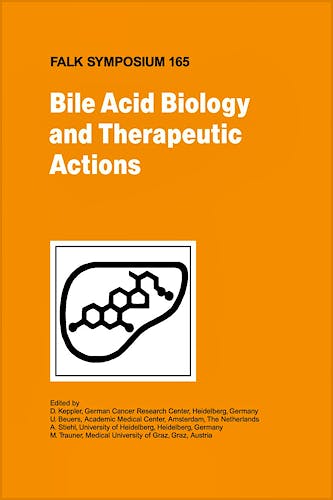

No hay productos en el carrito



Bile Acid Biology and Therapeutic Actions
Keppler, D
1ª Edición Marzo 2009
Inglés
320 pags
1000 gr
null x null x null cm
ISBN 9781402096433
Editorial SPRINGER
This book is the proceedings of the XX International Bile Acid Meeting, Falk Symposium 165 entitled ‘Bile Acid Biology and Therapeutic Actions’, held in Amsterdam, The Netherlands, June 13--14, 2008, and dedicated to both basic and clinical aspects of bile acid research with a focus on the role of bile acids in hepatobiliary diseases. The latest findings are presented by leading scientists and clinicians in the field.
Since the last International Bile Acid Meeting in Freiburg im Breisgau, Germany, in 2006, bile acid research has continued to flourish and therapeutic use of bile acids has attained a broader role. New insights have been gained into the mechanisms responsible for maintenance of bile acid homeostasis, and effects of bile acids on the cell signalling pathways have been further elucidated. Knowledge about the genetic basis of bile acid physiology has further increased. Therapy of chronic cholestatic liver diseases with ursodeoxycholic acid and new aspects of its chemopreventive properties continue to stimulate basic and clinical research and contribute to the understanding of underlying modes of action and to optimized treatment schedules.
Written for: Clinicians, researchers, graduate students, academics
Keywords:
- Gastroenterology
- Hepatology
Table of contents
List of principal contributors
List of chairpersons
Preface
SECTION I: METABOLISM AND TRANSPORT OF BILE ACIDS.- 1 Membrane asymmetry and the regulation of bile formation.- 2 ATP8B1, a phosphatidylserine flippase deficient in inherited intrahepatic cholestasis.- 3 Fic1-deficient rat hepatocytes reveal structural and functional defects in the bile canalicular membrane when exposed to hydrophobic bile acids.- 4 Bile acids and the brain: suggested pathogenetic mechanism in connection with formation of brain xanthomas in patients with cerebrotendinous xanthomatosis.- SECTION II: TRANSPORT OF BILE ACIDS.- 5 Canalicular microdomains and bile formation.- 6 Regulation of the cell surface expression and transport capacity of bile salt export pump by small chemical molecules.- 7 The role of <it>ABCB11</it> (BSEP) variation in susceptibility to intrahepatic cholestasis of pregnancy.- 8 Intracellular transport of bile salts.- 9 Conjugated bile acids regulate hepatic gluconeogenic genes via G&agr;i protein-coupled receptor(s) and the insulin signalling pathway.- SECTION III: TRANSPORT AND ACTIONS OF BILE ACIDS.- 10 Role of the organic solute transporter Ost&agr;-Ost&bgr; in intestinal basolateral bile acid transport and bile acid homeostasis.- 11 Mechanisms of regulation of bile acid transport in the small intestine.- 12 Expression and localization of the membrane-bound bile acid receptor TGR5 in human gallbladder tissue.- 13 Bile salts control the antimicrobial peptide cathelicidin through nuclear receptors in the human biliary epithelium.- 14 From Glarus to Gallenfarbstoffen: the scientific contributions of Rudi Schmid.- SECTION IV: NUCLEAR RECEPTOR REGULATION.- 15 Nuclear receptor regulation of bile acid transporters.- 16 Novel roles of liver X receptor in bile acid homeostasis and haptobiliary diseases.- 17 The nuclear hormone receptor Er&agr; plays a critical role in determining estrogen-induced cholesterol gallstones.- 18 Role of intestinal nuclear bile acid receptor FXR in the gut–liver axis.- SECTION V: BILE ACIDS AS METABOLIC INTEGRATORS.- 19 Linking nutrition and metabolism, a role for the membrane bile acid receptor TGR5.- 20 Potential role of ursodeoxycholic acid and its side-chain modified derivatives in the treatment of non-alcoholic fatty liver disease and associated atherosclerosis.- 21 Side-chain modification as critical determinant of the therapeutic properties of 24-<it>nor</it>ursodeoxycholic acid in <it>Mdr2</it> (<it>Abcb4</it>) knockout mice.- 22.- Role of side-chain amidation for the anticholestatic action of norursodeoxycholic acid in rat liver.- 23 Adolf Windhaus Prize Lecture: A central role for the organic solute and steroid transporter, Ost&agr;-Ost&bgr;, in the enterohepatic circulation of bile acids and structurally related molecules.- SECTION VI: BILE ACIDS: CELLULAR INJURY AND REGENERATION.- 24 Pro- and antiapoptotic actions of bile acids and CD95 ligand in hepatic stellate cells.- 25 Reactivation of hepatic organic anion transporters in different forms of acquired cholestasis by nuclear hormone receptor activators.- 26 Interactions between neuropeptides and bile acids in the modulation of cholangiocyte biology.- SECTION VII: BILE ACID-RELATED GENETIC LIVER DISEASE.- 27 The many faces of ABCB4 deficiency: the relevance of canalicular membrane-transporting proteins for human liver disease.- 28 Severe bile salt export pump (BSEP) deficiency: mutations, immunohistochemically assessed BSEP expression, and malignancy risk.- 29 Role of genetics in drug-induced liver injury.- 30 Variability of cholestatic liver disease in a family with an ABCB4 defect: ABCB4 mutation in 11 siblings.- 31 <it>ABCG5/G8</it> as a human risk gene for cholesterol gallstone disease.- 32 ATP8B1 deficiency: general background, clinical manifestations and possible therapeutic interventions.- 33 Bile acid abnormalities in peroxisomal disorders.- SECTION VIII: BILE ACIDS AS THERAPEUTIC AGENTS.- 34 Ursodeoxycholic acid for the treatment of primary sclerosing cholangitis.- 35 Excellent long-term survival in patients with primary biliary cirrhosis treated with ursodeoxycholic acid.- 36 Intravenous use of ursodeoxycholic disulphate – a unidirectional bile acid, for hepatoprotection in liver transplantation and total parenteral nutrition-associated cholestasis.- 37 Features, prognosis and management of primary biliary cirrhosis in the era of ursodeoxycholic acid.- Index
© 2026 Axón Librería S.L.
2.149.0